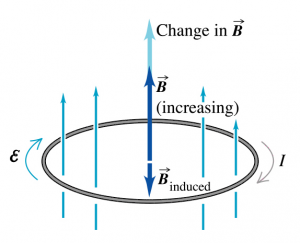Faraday’s Law
Tasks
- Predict the current vs. time in a wire loop if it is moved through a magnetic field as shown in the figure below.
- Measure the actual current through the wire using a galvanometer and a video recording device.
Resources
- Power supply
- Large Solenoid
- Small wire loop
- Galvanometer
- Wires with clips
- Phone or digital camera
Background
Magnetic fields can exert force on moving charged particles. In certain situations, they can cause charges to flow in wires, producing a voltage or electromotive force (EMF). A magnetic field will produce an EMF in a loop of wire if the total amount of magnetic field passing through the loop changes over time. This can be because the wire loop moves toward or away from the source of the magnetic field, or vice versa. The amount of EMF is given by \mathcal{EMF}=-N\frac{d}{dt}\Phi_B=-\frac{\Delta B}{\Delta t}NA\cos\theta where \Phi_B is the magnetic field flux, B is the magnetic field, A is the area of the wire loop, N is the number of turns in the wire loop, and \theta is the angle between the axis of the loop and the magnetic field direction.
Physically, the induced current in the wire moves in a direction such that it creates a magnetic field that opposes the direction of change of the external magnetic field through the loop, as shown by the minus sign in the equation above.

